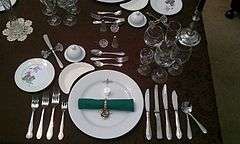Table knife

.png)

A table knife is an item of cutlery with a single cutting edge, and a blunt end - part of a table setting. Table knives are typically of moderate sharpness only, designed to cut prepared and cooked food.
History
The distinguishing feature of a table knife is a blunt or rounded end. The origin of this, and thus of the table knife itself, is attributed by tradition to Cardinal Richelieu around 1637, reputedly to cure dinner guests of the habit of picking their teeth with their knife-points.[1]
Later, in 1669, King Louis XIV of France banned pointed knives in the street and at his table, insisting on blunt tips, in the hope that it would reduce violence.[2][3]
In any table setting, the knife will typically be the piece to bear the maker's stamp, on the blade. The English city of Sheffield is noted for its cutlery manufacture and many knives bear the city's name in addition to the maker's.
In the past the blades were typically of carbon steel, with handles of bone, wood or ivory, but many modern examples are now made from a single piece of stainless steel for both handle and blade as per the example pictured.
See also
- Steak knife - with a pointed end, and a very sharp, often serrated, cutting edge
- Butter knife
- Knork
- Sporf
References
- ↑ Long, Tony (13 May 2008). "May 13, 1637: Cardinal Richelieu Makes His Point". Wired.com. Retrieved 15 July 2010.
- ↑ Patrick, Bethanne Kelly; John Thompson, Henry Petroski (2009). An Uncommon History of Common Things. Washington, D.C.: National Geographic. ISBN 1-4262-0420-5. Retrieved 7 October 2013.
- ↑ Emma Hern; Will Glazebrook, Mike Beckett (2005). "Reducing knife crime". BMJ Editorial. doi:10.1136/bmj.330.7502.1221.